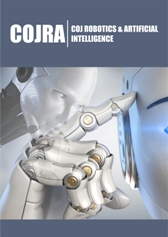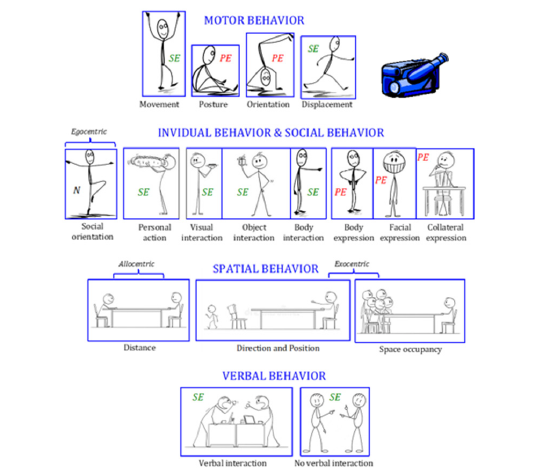- Submissions

Full Text
COJ Robotics & Artificial Intelligence
Real Behavior and Virtual Behavior: Ethological Approach to Study the Interfaces in The Case of Manned Space Missions
Tafforin C*
Ethospace, Research and Study Group in Human and Space Ethology, France
*Corresponding author: Carole Tafforin, Ethospace, 13 Rue Alsace Lorraine, 31000 Toulouse, France
Submission: August 08, 2024;Published: August 27, 2024

ISSN:2832-4463 Volume4 Issue1
Abstract
Our study addresses issues on association of real behavior manifestations and virtual behavior conceptions with a specific methodology-based solution. Human ethology treats of the interfaces with the goal to analyze optimal relationships between the individual and the environment in the case of crews’ adaptation to long-duration spaceflights. We assume the efficiency of Robotics and Artificial Intelligence in this problematic. Ethological method consists in observation, description and quantification of the motor, individual, social, spatial and verbal behaviors in usual activities, working tasks or experimental tests. Discussion suggests steps of relevant methodological applications and related technological innovations in the approach of adequacies or peculiarities inherent to humans’ daily life situations or to humanoids’ daily life imitations. From an interdisciplinary perspective, prospects are for physical support, psychological support and operational support contributing to the well-being of future travelers in deep space.
Keywords:Ethology; Methods; Human behavior; Optimization; Virtual reality; Artificial intelligence; Well-being; Moon and mars missions; Long-duration space exploration
Introduction
In Ethology, real behavior is the manifestation of the optimal relationships between the individual and his/her environment. In Robotics and Artificial Intelligence (AI), virtual behavior results from the optimal process of improving the operational efficiency of the AI model and at the same time, of enhancing the effectiveness of the model itself. Issues are to associate those concepts with the goal to serve, to cooperate, to support humans adapting to new living and working conditions while humanoids adapting to their performance. Highlights are in the case of manned space missions. Replacing a person with an AI system in order avoid subjective factors in this or that situation [1] is not the purpose of our study. Future interplanetary flights will improve as intelligent missions by associating AI with Human Intelligence (HI) considered as the synergy of Individual Intelligence, Emotional Intelligence and Collective Intelligence [2]. In such a promising interdisciplinary approach, we propose to initiate analyses of the interfaces with a focus on the methodological tools applied to behavioral studies in the space domain.
Case Presentation
In the history of the discipline, Konrad Lorenz received the Nobel Prize for his seminal work in animal ethology in 1973 [3]. The notion of stimulus-trigger that generates a behavior has been demonstrated in numerous experiments [4]. The idea is to determine relevant signals so that they can be perceived as effective in the behavioral responses. AI-based robots can process in that way toward interactions with humans. One major capacity is to mutually read the observable behaviors, which is the very basis of proposed ethological tools. Observation is the starting point [5] and modern human ethology offers a proven methodology in space scientific investigations. The three phases are:
P1. Observation
Behavior is a spontaneous phenomenon. This event (emergence from the individual-environment relationship) appears in the form of a motor activity performed by a subject and represents a spontaneous manifestation visible to the human eye on objective criteria. The approach is to observe the subject’s behavior in habitual situations such as tasks of daily living or work tasks as well as experimental tests.
P2. Description
The observed subject performs a motor activity, even when immobile. Whether dynamic or static, there is always a fact (action, interaction, expression, communication, etc.) or a state (posture, orientation, position, etc.) to be continuously described. The approach is to build a system of units that breaks down this continuity and codifies it into behavioral items.
P3. Quantification
In the flow of occurrences of these items, the process is to move from a qualitative discourse to a quantitative discourse that accounts for continuity in its analogical aspects as mathematical measures (number, frequency, duration) or geometric measures (distance, position, utilization). We thus proceed to the quantification of descriptive data. Chosen material and method allow for rigorous comparison between situations, between subjects, or for the same subject in the same situation, at different times of the individual and social evolution, in different environments.
In the case of real space flights, analog conditions or experimental campaigns, human observer uses video recordings collected in situ de visu in toto. His/her tool consists in predefined objective behavioral repertoire for coding observational and descriptive data. A software-based solution is The Observer XT® as useful device for organizing, filtering, processing and visualizing data, as point events (short occurrence) or state events (occurrence duration >3s.) [6]. According to the macro- or micro-level of observation, different behavioral categories are set out for description in term of action verbs or cartographic statements (egocentric, allocentric or exocentric references). MOTOR BEHAVIOR defines movements (e.g. “raise arms”), postures (e.g. “sat”), orientations (e.g. “head-down”), displacements (e.g. “walk”). INDIVIDUAL BEHAVIOR defines all personal actions (e.g. “eat”) and SOCIAL BEHAVIOR defines social orientations (i.e., number of subjects in the visual field), visual interactions (e.g. “look at subject A”), object interactions (e.g. “give object to subject B”), body interactions (e.g. “show something to subject C”), body expressions (e.g. “place with hands on hips”), facial expressions (e.g. “smile”), collateral expressions (e.g. “chew pen”). SPATIAL BEHAVIOR delimits inter-individual distances (i.e. intimate distance <40cm, personal distance 40-120cm, social distance 120-360cm, public distance >360cm) [7], directions (e.g. “move forwards”), positions (e.g. “sit at table”), space occupancy (e.g. “5 subjects in an area”). VERBAL BEHAVIOR defines verbal interactions (e.g. “ speak to subject B”) vs. no verbal interactions (Figure 1).
Figure 1:Observational and descriptive data used in the ethological approach. SE= State Event; PE= Point Event;N= Number of subjects.

Humor is a coping strategy in long-duration space flight [8]. It results from a state of mind that allows the expression of positive feelings in events pleasant from a revisited reality. Humankind is endowed with this spirit skill that involves the emotional intelligence, one of the three forms composing HI. Out of reality, AI is only endowed with learning skill to mime the facial expressions that humor generates such as smiling or laughing. The ethological approach can deal with this interface. On one hand, humans express positive emotions by their associated behavioral manifestations and on the other hand, humanoids display the associated virtual images that will generate facial expressions in humans, thus establishing HI-IA relationships. In a comprehensive approach, we consider the whole manifestations within the categories of motor behavior, individual behavior & social behavior, spatial behavior and verbal behavior.
Discussion
With the new challenge of long-term duration space exploration, astronaut’s behavioral health will impose the need for relevant methodological applications and related technological innovations. The emphasis on the interfaces between Ethology with Robotics and AI becomes obvious from an interdisciplinary perspective. The first step would be to analyze real behavior manifestations exhaustively in daily live situations through movements, postures, orientations, interactions, expressions, communications and displacements (choice of performance made possible in robotics and AI) that are observed, described and quantified by using specific tools of the ethological method.
The second step would be to associate them with virtual behavior conceptions through adequacies or peculiarities inherent to humans’ daily life situations or to humanoids’ daily live imitations by using rigorously the same method. Situational and experimental protocols will be designed for recommendation and validation. The final step would be to find to what extend both manifestations and conceptions could serve for the well-being of future interplanetary crews with the mission success goal. In a broad range of space environments (parabolic flights, orbital flights, space stations) and analog environments (polar bases, confinement and isolation experiments, water immersion), our three-decade ethological research in the field showed a multi-system human adaptation to such unexplored, unusual or extreme environments [9].
Prospects for physical support, psychological support and operational support should help humanity to travel in deep space. New ideas are for instance, Virtual Reality (VR) technologies by creating a sensorimotor interactive world of visual images and videos that serve for the lost terrestrial reality such as restoration of the wide exterior nature and the crewmembers’ own interior home [10]. Voice assistants may act as communicative companion to compensate the lack of audial information from Ground Control Crew and to overcome social isolation and family deprivation.
The future potential of VR is also helpfulness for instance, to deliver collaborative cognitive-behavioral formulation in the absence of real-time communication [11] expressly in the case of a 40-minute delay during remote contacts from Mars to Earth. Positive benefits are also to properly live in an extended lifetime on Earth such as for instance, virtual imagery guiding meditation in older adults under healthcare protocols [12]. VR training in Olympic sports promises increasingly feedback from scientific researcher about real effects on sport performance enhancement [13]. The prime interest of these innovations with regard to the astronauts’ demanding physical exercises is a better visual comfort especially in the case of endurance missions on the Moon and beyond. Openings are to develop countermeasures in these respects [14]. As conclusion, future research and study paradigms might be designed to look at the optimal relationships between the individual and the joint real and virtual environment.
Acknowledgement
This study was supported by the French Space Agency (CNES) with the grant n°5800002932.
References
- Voronin AN, Savchenco AS (2024) Multi-criteria problems of artificial intelligence. COJ Rob Artificial Intel 3(5): 1-4.
- Tafforin C (2020) Human missions analysis for intelligent missions improvement. In: Pezzella G, Viviani A (Eds.), Mars exploration: A step forward. Intech Open, London, United Kingdom, pp. 113-126.
- Lorenz K (1997) The foundations of ethology. Flammarion, Paris, France, pp. 1-426.
- Campan R, Scapini F (2002) Ethology. Systems approach to behavior. De Boeck University, Brussels, Belgium, pp. 56-65.
- Bonetto E, Guiller T, Adam-Torian J (2023) Hum Ethol 38: 008-016.
- Tafforin C, Gerebtzoff D (2010) A software-based solution for research in space ethology. Aviation Space Environ Med 81(10): 951-956.
- Hall ET (1971) The hidden dimension. Threshold, Paris, France, pp. 144-160.
- Brcic J, Suedfeld P, Johnson P, Huynh T, Gushin V (2016) Humor as a coping strategy in spaceflight. Acta Astronaut (152): 175-178.
- Tafforin C, Kanas N, Giner Abati F, Tamponnet C (2023) Three decades of ethological research in the space field within an interdisciplinary framework. Acta Astronaut (211): 229-237.
- Gushin V, Ryumin O, Karpova O, Rozanov I, Shved D, et. al. (2021) Prospects for psychological support in interplanetary expeditions. Front Physiol 12: 750414.
- Thomas LJ (2023) The future potential of virtual reality countermeasures for maintaining behavioral health during long duration space exploration. Front Virtual Real 4: 11801652023.
- Cinalioglu K, Lavin P, Bein M, Lesage M, Gruber J, et. al. (2023) Effects of virtual reality guided meditation in older adults: The protocol of a pilot randomized controlled trial. Front Psychol 14: 1083219.
- Richlan F, Weiss M, Kasner P, Braid J (2023) Virtual training, real effects: A narrative review on sport performance enhancement through interventions in virtual reality. Front Psychol 14: 1240790.
- Pagnini F, Manzey D, Rosnet E, Ferravente D, White O, et. al. (2023) Human behavior and performance in deep space exploration: Next challenges and research gaps. NPJ Microgravity. 9(27).
© 2024 Tafforin C. This is an open access article distributed under the terms of the Creative Commons Attribution License , which permits unrestricted use, distribution, and build upon your work non-commercially.
 a Creative Commons Attribution 4.0 International License. Based on a work at www.crimsonpublishers.com.
Best viewed in
a Creative Commons Attribution 4.0 International License. Based on a work at www.crimsonpublishers.com.
Best viewed in 







.jpg)






























 Editorial Board Registrations
Editorial Board Registrations Submit your Article
Submit your Article Refer a Friend
Refer a Friend Advertise With Us
Advertise With Us
.jpg)






.jpg)














.bmp)
.jpg)
.png)
.jpg)










.jpg)






.png)

.png)



.png)






